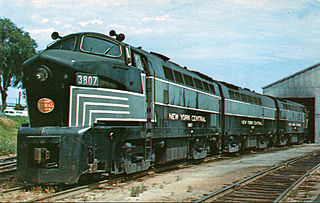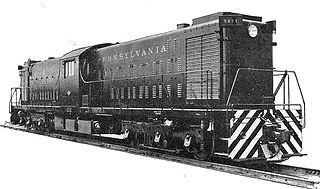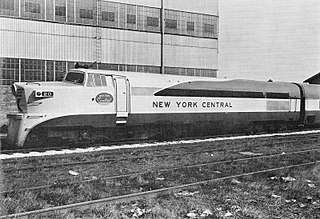Related Research Articles

The Baldwin Locomotive Works (BLW) was an American manufacturer of railway locomotives from 1825 to 1951. Originally located in Philadelphia, Pennsylvania, it moved to nearby Eddystone in the early 20th century. The company was for decades the world's largest producer of steam locomotives, but struggled to compete when demand switched to diesel locomotives. Baldwin produced the last of its 70,000-plus locomotives in 1951, before merging with the Lima-Hamilton Corporation on September 11, 1951, to form the Baldwin-Lima-Hamilton Corporation.

Locomotive classification on the Pennsylvania Railroad took several forms. Early on, steam locomotives were given single-letter classes. As the 26 letters were quickly assigned, that scheme was abandoned for a more complex system. This was used for all of the PRR's steam locomotives, and — with the exception of the final type bought — all electric locomotives also used this scheme.

The EMD FL9 is a model of electro-diesel locomotive, capable of operating either as a traditional diesel-electric locomotive or as an electric locomotive powered from a third rail. Sixty units were built between October 1956 and November 1960 by General Motors Electro-Motive Division for the New York, New Haven and Hartford Railroad. The locomotives were designed to allow diesel powered trains to enter Grand Central Terminal, where non-electric locomotives are forbidden. The FL9s continued in passenger service under the New Haven's successors, with the final units in revenue service retired by Metro-North Railroad in 2009. A number of FL9s have been preserved at museums or with private owners.

The EMD SD60 is a 3,800 horsepower (2,800 kW), six-axle diesel-electric locomotive built by General Motors Electro-Motive Division, intended for heavy-duty drag freight or medium-speed freight service. It was introduced in 1984, and production ran until 1995.

The Consolidation Line was a series of diesel-electric railway locomotive designs produced by Fairbanks-Morse and its Canadian licensee, the Canadian Locomotive Company. Railfans have dubbed these locomotives C-liners, however F-M referred to the models collectively as the C-Line. A combined total of 165 units were produced by F-M and the CLC between 1950 and 1955.

The Baldwin S-12 or BLH S12 is a 1,200-horsepower (890 kW) diesel-electric switcher locomotive. Utilizing a turbocharged 6-cylinder version of the powerful 606A diesel prime mover, S12s were known for their "lugging" power, despite being temperamental. Like most BLH switchers, the S12 had AAR Type-A switcher trucks in a B-B wheel arrangement. 451 units were built between 1951 and 1956, when BLH left the locomotive market.

The EMD Model 40 was a two-axle diesel-electric switcher locomotive built by Electro-Motive Corporation (EMC), and its corporate successor, General Motors' Electro-Motive Division (EMD) between August 1940 and April 1943. Nicknamed "critters", eleven examples of this locomotive were built. Powered by twin General Motors Detroit Diesel 6-71 diesel engines, which produce a combined 300 horsepower (224 kW), its drivetrain is unusual because the two diesel engines are used to drive the electric DC generator from both sides, one with clockwise rotation and the other with counter-clockwise rotation.

The Baldwin VO-660 was a diesel-electric switcher locomotive built by Baldwin Locomotive Works between April, 1939 and May, 1946. The 197,520–203,980 lb units were powered by a six-cylinder diesel engine rated at 660 horsepower (492 kW), and rode on two-axle AAR Type-A switcher trucks in a B-B wheel arrangement. 142 examples of this model were built for American railroads, along with the United States Navy. Baldwin replaced the VO-660 with the model DS-4-4-660 in 1946.

The BLH S8 was an 875-horsepower (652 kW) diesel–electric switcher locomotive. The Baldwin-Lima-Hamilton Corporation produced a total of 63 units between 1951 and 1953. Of these, nine were calf units built for Oliver Iron Mining Company in Minnesota. A tenth calf had been built for them on order, but when delivery was refused, it was fitted with a cab, and converted to a regular S8.
The FM H-12-46 was a light road switcher of Fairbanks-Morse design manufactured exclusively by the Canadian Locomotive Company from October, 1951–January, 1953 for the Canadian National Railway. Only thirty of the 1,200 hp, six-cylinder opposed piston engine locomotives were produced. The units were configured in an A1A-A1A wheel arrangement, mounted atop a pair of three-axle trucks.

The BLH RF-16 is a 1,625-horsepower (1,212 kW) cab unit-type diesel locomotive built for freight service by the Baldwin-Lima-Hamilton Corporation between 1950 and 1953. All RF-16s were configured with a B-B wheel arrangement and ran on two AAR Type B two-axle road trucks, with all axles powered. A total of 109 cab-equipped A units were built, along with 51 cabless booster B units, for a total of 160 locomotives built. As was the case with most passenger locomotives of its day, the RF-16s came equipped with a retractable, nose-mounted drop coupler pilot. Unlike competing units from EMD and Alco, the RF-16 used an air-powered throttle, meaning that it could not be run in MU operation with EMD or Alco diesels without special MU equipment.

The New Haven EP-5 was a double-ended mercury arc rectifier electric locomotive built in 1955 by General Electric, for the New York, New Haven and Hartford Railroad. It was built to haul passenger trains between Grand Central Terminal or Penn Station in New York City and New Haven, Connecticut. The EP-5s resembled the Alco FA and even more resembled the Pennsylvania Railroad Class E2b.

The A-3149 (LS-750) and A-3171 (LS-800) were diesel-electric switching locomotives built between November 1949 and June 1951, by the Lima-Hamilton Corporation of Lima, Ohio, U.S.A.. The A-3149 is a 750 horsepower (560 kW) switcher. It was later upgraded to 800 hp (600 kW) by changing fuel rack settings. Both models used the same turbocharged Hamilton T69SA four-stroke, six cylinder inline diesel engine, a Westinghouse generator and 4 Westinghouse traction motors.

The A-3177 (LT-2500) was a diesel-electric transfer-unit locomotive, built by the Lima-Hamilton Corporation between 1950 and 1951. The A-3177 was the final locomotive model produced by Lima-Hamilton before the company merged with the Baldwin Locomotive Works in September 1951 to form the Baldwin-Lima-Hamilton Corporation (BLH).

The A-3170 (LS-1200) is a diesel-electric switcher locomotive built between May 1950 and August 1951, by the Lima-Hamilton Corporation of Lima, Ohio, United States. Lima's original design was the A-3080, a 1,000 hp (750 kW) switcher, which became the standard for Lima's designs. A 660 hp (490 kW) switcher had also been designed at the request of American Rolling Mill Company, but none were built. By changing fuel rack settings, the A-3080 was upgraded to the A-3170 producing 1,200 horsepower (890 kW) from a turbocharged Hamilton T89SA four-stroke, eight cylinder inline diesel engine, a Westinghouse generator and 4 Westinghouse traction motors provided the 74,508 lbf of tractive effort.
The A-3080 (LS-1000) is a diesel-electric switcher locomotive built between May 1949 and April 1950, by the Lima-Hamilton Corporation of Lima, Ohio, United States. The A-3080 is a 1,000 hp switcher, which became the standard for Lima's designs. By changing fuel rack settings, the A-3080 was upgraded to the A-3170, producing 1,200 horsepower from the same turbocharged Hamilton T89SA four-stroke, eight cylinder inline diesel engine, a Westinghouse generator and four Westinghouse traction motors provided the 74,508 lbf of tractive effort.

The BLH RS-12 was a class of 1,200 hp (895 kW) diesel-electric road switcher locomotives configured with an AAR type B-B wheel arrangement. It was the follow-on model to the former Baldwin DRS-4-4-1000, first introduced in 1948. It was more successful than its predecessor selling 50 units to eight railroads, versus 22 units to three railroads. Only one railroad, The Pennsylvania Railroad bought both models.
The BLH RT-624 was a twin-engined diesel-electric locomotive, built by Baldwin-Lima-Hamilton Corporation between August 1951 and February 1954.

The RP-210 was a streamlined 1,000 hp (750 kW) locomotive built in 1956 by Baldwin-Lima-Hamilton, specifically to operate with the experimental, all-aluminum Train-X coaches that were built by the Pullman-Standard Car Manufacturing Company. The model represented Baldwin's attempted entry into the lightweight passenger locomotive market, but only three of the low-slung diesel-hydraulic units were produced. The first RP-210 was built for the New York Central Railroad to power their Ohio Xplorer train between Cleveland, Columbus, and Cincinnati, and a pair was purchased by the New York, New Haven and Hartford Railroad to double-end their Dan'l Webster, running between New York City and Boston.
References
- Kirkland, John F. (November 1985). The Diesel Builders Volume 1: Fairbanks-Morse and Lima-Hamilton. Interurban Press. ISBN 0-916374-69-6.
- "The Yard Limit - Lima" . Retrieved March 9, 2009.
- Reid, Robert H. (Ed.). (March 1 1974). Penn Central Diesel Spotter's Guide. yumpu.com. Retrieved January 1, 2023, from https://www.yumpu.com/s/9aeKaGqhvVbSHWeX
- Penn Central Motive Power Summary. The Diesel Shop. Retrieved January 1, 2023, from https://thedieselshop.us/PennCentral.HTML